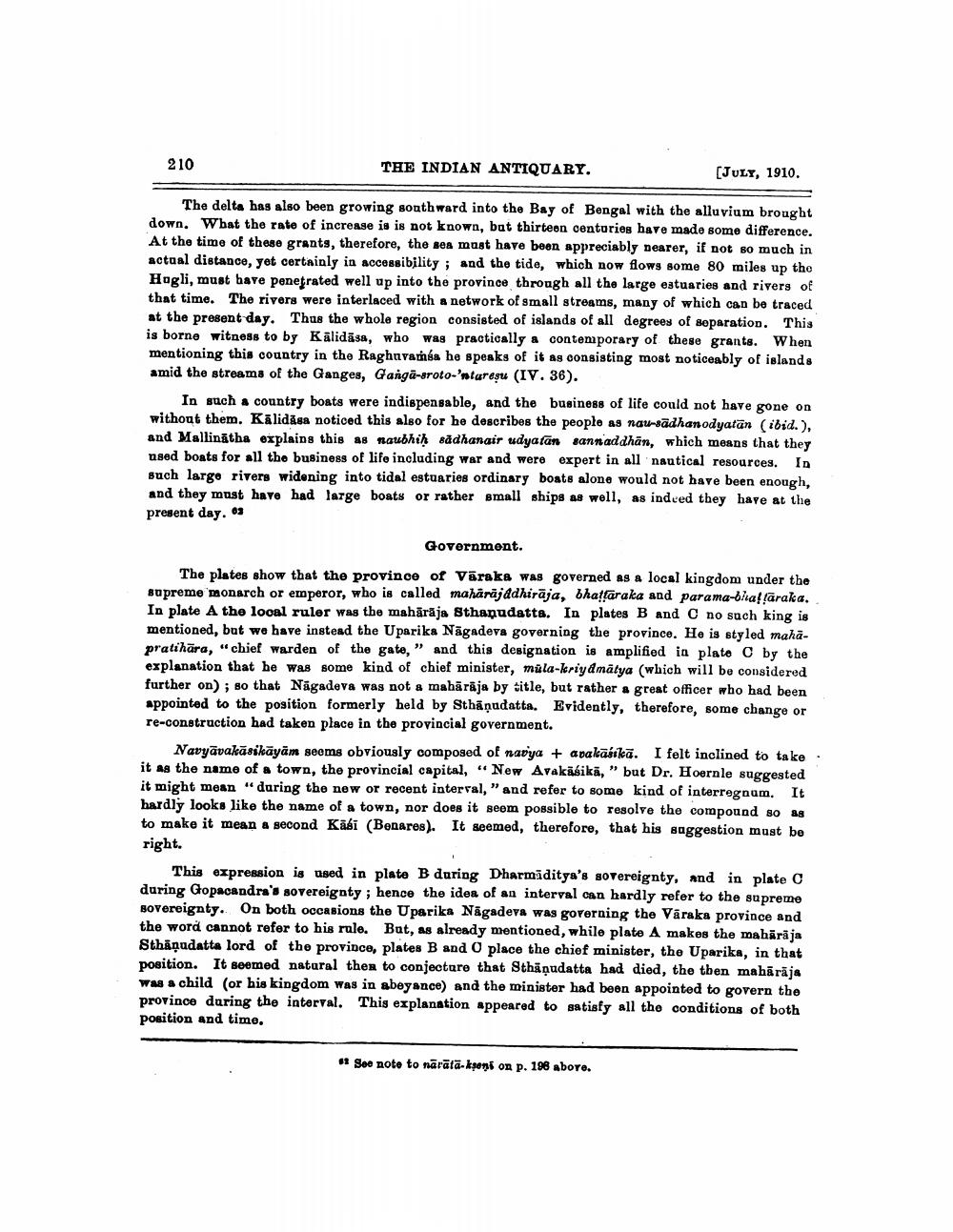________________
210
THE INDIAN ANTIQUARY.
(JULY, 1910.
The delta has also been growing south ward into the Bay of Bengal with the alluvium brought down. What the rate of increase is is not known, but thirteon centuries have made some difference. At the time of these grants, therefore, the sea must have been appreciably Dearer, if not so much in actual distance, yet certainly in accessibility; and the tide, which now flows some 80 miles up the Hogli, must have penetrated well up into the province through all the large estuaries and rivers of that time. The rivers were interlaced with a network of small streams, many of which can be traced at the present day. Thus the whole region consisted of islands of all degrees of separation. This is borne witness to by Kālidāsa, who was practically a contemporary of these grants. When mentioning this country in the Raghavamsa he speaks of it as consisting most noticeably of islands amid the streams of the Ganges, Ganga-eroto-'ntareşti (IV. 36).
In such a country boats were indispensable, and the business of life could not have gone on without them. Kā lidsa noticed this also for he describes the people as nau-sādhanodyatān (ibid.), and Mallinātha explains this as naubhiḥ sadhanair udyafan sannaddhān, which means that they nsed boats for all the business of life including war and were expert in all nautical resources. In such large rivers widening into tidal estuaries ordinary boats alone would not have been enough, and they must have had large boats or rather small ships as well, as indeed they have at the present day. 03
Government.
The plates show that the province of Vāraks was governed as a local kingdom under the Bupreme monarch or emperor, who is called maharajadhirāja, bhatfaraka and parama-basaraka. In plate A the local ruler was the mahārāja Sthanudatta. In plates B and C no such king is mentioned, but we have instead the Uparika Nāgadeva governing the province. He is styled mahapratihāra, chief warden of the gate,” and this designation is amplified in plato C by the explanation that he was some kind of chief minister, müla-kriyamatya (which will be considered further on), so that Nágadeva was not a mahārāja by title, but rather a great officer who had been appointed to the position formerly held by Sthāņudatta. Evidently, therefore, some change or re-construction had taken place in the provincial government.
Navyāvakāsikāyām seems obviously composed of narya + apakasikā. I felt inclined to take it as the name of a town, the provincial capital, “New Avakäsikā,” but Dr. Hoernle suggested it might mean “during the new or recent interval," and refer to some kind of interregnum. It hardly looks like the name of a town, nor does it seem possible to resolve the compound so ag to make it mean a second Kābi (Benares). It seemed, therefore, that his suggestion must be right.
This expression is used in plate B during Dharmiditya's sovereignty, and in plate during Gopacandra's sovereignty; hence the idea of an interval can hardly refer to the supreme Bovereignty. On both occasions the Uparika Nāgadeva was governing the Vāraka province and the word cannot refer to his rule. But, as already mentioned, while plate A makes the mahārāja Sthäņadatta lord of the province, plates B and O place the chief minister, the Uparika, in that position. It seemed natural then to conjecture that Sthåņudatta had died, the then mahārājs was a child (or his kingdom was in abeyance) and the minister had been appointed to govern the province during the interval. This explanation appeared to satisfy all the conditions of both position and time.
Soo note to nārātā-kseni on p. 198 xboro.




